How to Improve Your Business’s Cybersecurity With Centralized Authentication
Key Points in This Article
- Centralized authentication is a key component of effective employee management and cybersecurity.
- Implementing centralized authentication can help ensure you can manage employees, expenditures, and cybersecurity-related risks.
- Failing to do so can leave you tremendously vulnerable, whether from a disgruntled employee or a hacker.
When an employee leaves your organization, are you sure they no longer have access to all the software packages available? You may have cut off access to their email, but do they still have access to your financial software, CRM, or project management software? And do they still have any access to any aspect of your intellectual property (IP)?
Similarly, have you eliminated all of a vendor or supplier’s access to your accounting, logistics, or other systems when you cut ties with them?
If the answer is “No” or “I’m not sure.” You must understand how essential centralized authentication is to your business’s cybersecurity and take the first steps to implement it across your organization.
What Is Centralized Authentication?
Centralized authentication means that all user access is controlled in one central location. With centralized authentication, you have one server to access your employees and other stakeholders. Whether it’s your financial software, CRM, or file server, you have one central location from which you control whether a user can access a program and what tasks they can perform when they have access.
Today, centralized authentication is more important than ever. It’s rare these days that every employee works in a single office building. Businesses have long employed sales staff who work remotely much of the time. And before the pandemic, IT and some other functions were seeing a slow but steady shift to remote-only work. But now, many employees in all departments enjoy hybrid-remote, and in some cases, fully remote, working conditions. Some companies even operate as remote-only endeavors, with employees often sharing financial and proprietary information digitally across the globe.
Even businesses in which employees must work on-site often rely on online third-party organizations and systems for essential services. Think about the number and location of full-time and temporary employees and vendors who access your network. Now consider the times of day they access your network, especially if you have employees or vendors in different time zones.
With abundant access points and network activity, businesses must manage user access from a central location.
Why Centralized Authentication Is Critical to Management
Centralized authentication is critical to employee management. First, when your user’s access is controlled centrally, you can ensure that employees only access the files they’re supposed to. You can limit or allow employee access to specific files and systems to improve productivity and help keep employees from straying off task.
You can also manage expenses. Businesses typically buy a finite number of licenses for third-party systems. It’s easier to manage your licenses if you can view and manage access to them in one place. It’s also easy to determine whether third-party systems are being used enough to justify their expense.
Further, if you have all of your user access controlled from one location, you can quickly and completely sever an employee or vendor’s access to your business when they leave, are let go, or their contract expires. Terminated employees or angry former vendors who retain access to your systems can cause much damage, and you can’t afford that risk.
Even if an employee or vendor leaves on good terms, their retaining access to your systems presents a security risk. They could access your system for some reason and inadvertently erase data. Or their access controls could be compromised by a hacker or scammer, who can now access your network.
Why Centralized Authentication Is Critical to Cybersecurity
Centralized authentication also helps you manage compromised accounts. If you believe a third party has gained access to a user’s login credentials, you can quickly shut down that user’s access to help you safeguard your systems. Without centralized authentication, you’ll need to waste precious time reaching out to multiple departments to shut down their access system by system. And in that time, a hacker could steal invaluable information, download malware, or wreak havoc in other ways.
Further, centralized authentication helps you audit your systems in the event of a cyber attack. If all user access is controlled from a central location, you can easily see who accessed what and when. Being able to do so is critical to tracing the origins of a cyber attack. If you suffer a data breach, you’ll want to understand how hackers got into your system to help law enforcement officials identify the culprit and shore up that vulnerability so that it can’t be exploited again.
Centralized authentication also allows you to conduct user access reviews – assessments of what your users are doing on your network. Regularly scheduled user access reviews are critical to ensuring that only authorized users are on your network. User access review information and other data you gather about your network and infrastructure can also help you identify potential areas of vulnerability before an attack occurs.
But if you don’t have centralized authentication, you risk having unauthorized users on your network and stale accounts eating up resources and presenting security risks. You also will find it more difficult to prevent a cyberattack from being successful or analyze it appropriately after the fact.
Is Centralized Authentication the Same as Single Sign-On?
You may wonder if centralized authentication is the same as single sign-on (SSO). The two are complimentary but not quite the same. From a cybersecurity perspective, centralized authentication ensures that one server controls who has access. SSO is designed for user ease of access, allowing one set of access credentials to be used and authenticate access to multiple applications. But typically, that single set of login credentials is controlled centrally.
You can have centralized authentication without SSO; with it, users must re-enter their credentials for each application they access. However, many businesses implementing centralized authentication also implement SSO, as SSO is found in many of the most common identity and access management systems.
While it may take time to consolidate your systems and find the appropriate vendor to help you implement centralized authentication, you can’t afford to do so. Consider how much damage a disgruntled employee could do with your client list or a hacker could take from your business accounts. When you compare it to the time and expense you may expend implementing centralized authentication, you’ll see the benefits outweigh the costs.
Contents



